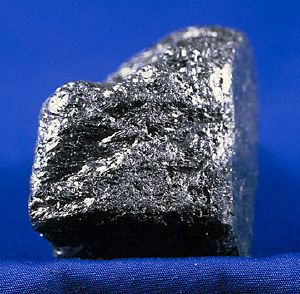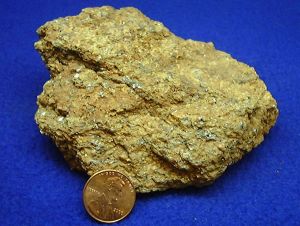Graphite
| Graphite | |
|---|---|
| General | |
| Category | Native mineral |
| Chemical formula | Carbon, C |
| Identification | |
| Color | Steel black, to grey. |
| Crystal habit | Tabular, six-sided foliated masses, granular to compacted masses. |
| Crystal system | Hexagonal (6/m 2/m 2/m) |
| Cleavage | Perfect in one direction. |
| Fracture | Flaky, otherwise rough when not on clevage |
| Mohs Scale hardness | 1 - 2 |
| Lustre | Dull metallic, earthy |
| Refractive index | Opaque |
| Pleochroism | None |
| Streak | Black |
| Density | 2.09–2.23 g/cm³ |
| Fusibility | ? |
| Solubility | Molten Ni |
Graphite (named by Abraham Gottlob Werner in 1789, from the Greek γραφειν: "to draw/write", for its use in pencils) is one of the allotropes of carbon. Unlike diamond, graphite is a conductor, and can be used, for instance, as the material in the electrodes of an electrical arc lamp. Graphite holds the distinction of being the most stable form of solid carbon ever discovered.
Occurrence
Associated minerals include: quartz, calcite, micas, iron meteorites and tourmalines. Notable occurrences include New York and Texas in the USA, Russia, Mexico, Greenland, and India.
Other characteristics: thin flakes are flexible but inelastic, mineral can leave black marks on hands and paper, conducts electricity, and displays superlubricity. Best field indicators are softness, luster, density and streak.
Structure
Each carbon atom is covalently bonded to three other surrounding carbon atoms. The flat sheets of carbon atoms are bonded into hexagonal structures. These exist in layers, which are not covalently connected to the surrounding layers.
The unit cell dimensions are a = b = 245.6 picometres, c = 669.4 pm. The carbon-carbon bond length in the bulk form is 141.8 pm, and the interlayer spacing is c/2 = 334.7 pm.
Each carbon atom possesses an sp2 orbital hybridisation. The pi orbital electrons delocalized across the hexagonal atomic sheets of carbon contribute the graphite's conductivity. In an oriented piece of graphite, conductivity parallel to these sheets is greater than that perpendicular to these sheets.
Detailed properties and uses
The acoustic and thermal properties of graphite are highly anisotropic, since phonons propagate very quickly along the tightly-bound planes, but are slower to travel from one plane to another.
Graphite is able to conduct electricity due to the unpaired fourth electron in each carbon atom. This unpaired 4th electron forms delocalised planes above and below the planes of the carbon atoms. These electrons are free to move, so are able to conduct electricity. However, the electricity is only conducted within the plane of the layers.
Graphite powder is used as a dry lubricant, although it might be thought that this industrially important property is due entirely to the loose interlamellar coupling between sheets in the structure, in fact in a vacuum environment (such as in technologies for use in space), graphite was found to be a very poor lubricant, leading to the discovery that in fact lubrication is due to adsorbed air and water between the layers, unlike other layered dry lubricants such as molybdenum disulfide. Recent studies suggest that an effect called superlubricity can also account for this effect.
When a large number of crystallographic defects bind these planes together, graphite loses its lubrication properties and becomes what is known as pyrolytic carbon, a useful material in blood-contacting implants such as prosthetic heart valves.
Natural and crystalline graphites are not often used in pure form as structural materials due to their shear-planes, brittleness and inconsistent mechanical properties.
In its pure glassy (isotropic) synthetic forms, pyrolytic graphite and carbon fiber graphite is an extremely strong, heat-resistant (to 3000 °C) material, used in reentry shields for missile nosecones, solid rocket engines, high temperature reactors, brake shoes and electric motor brushes.
Intumescent or expandable graphites are used in fire seals, fitted around the perimeter of a fire door. During a fire the graphite intumesces (expands and chars) to resist fire penetration and prevent the spread of fumes. A typical start expansion temperature (SET) is between 150 and 300 degrees Celsius.
Carbon fiber and carbon nanotubes are also used to graphite reinforced plastics, and in heat-resistant composites such as reinforced carbon-carbon (RCC)). They have also successfully reinforced concrete. The mechanical properties of carbon fiber graphite-reinforced plastic composites and grey cast iron are strongly influenced by the role of graphite in these materials.
Graphite also finds use as a matrix and moderator within nuclear reactors. Its low neutron cross section also recommends it for use in proposed fusion reactors. Care must be taken that reactor-grade graphite is free of neutron absorbing materials such as boron, widely used as the seed electrode in commercial graphite deposition systems— this caused the failure of the German's World War II graphite-based nuclear reactors. Since they could not isolate the difficulty they were forced to use far more expensive heavy water moderators.
Media
|
|
See also
- Carbon fiber
- Pyrolytic graphite
- Diamond
- Lonsdaleite
- Graphene
- Carbon nanotube
- Pencil lead
Reference
- Klein, Cornelis and Cornelius S. Hurlbut, Jr. (1985) Manual of Mineralogy: after Dana 20th ed. ISBN 0-471-80580-7
External links
- The Graphite Page
- Mineral galleries
- Webmineral
- Mindat w/ locations
- Intumescent graphite for fireproofing
ar:جرافيت ca:Cristal·lografia da:Grafit de:Graphit et:Grafiit es:Grafito eo:Grafito fr:Graphite it:Grafite he:גרפיט lt:Grafitas hu:Grafit nl:Grafiet ja:グラファイト no:Grafitt pl:Grafit pt:Grafite ru:Графит sk:Grafit sv:Grafit th:แกรไฟต์ vi:Than chì zh:石墨
Credits
New World Encyclopedia writers and editors rewrote and completed the Wikipedia article in accordance with New World Encyclopedia standards. This article abides by terms of the Creative Commons CC-by-sa 3.0 License (CC-by-sa), which may be used and disseminated with proper attribution. Credit is due under the terms of this license that can reference both the New World Encyclopedia contributors and the selfless volunteer contributors of the Wikimedia Foundation. To cite this article click here for a list of acceptable citing formats.The history of earlier contributions by wikipedians is accessible to researchers here:
The history of this article since it was imported to New World Encyclopedia:
Note: Some restrictions may apply to use of individual images which are separately licensed.


